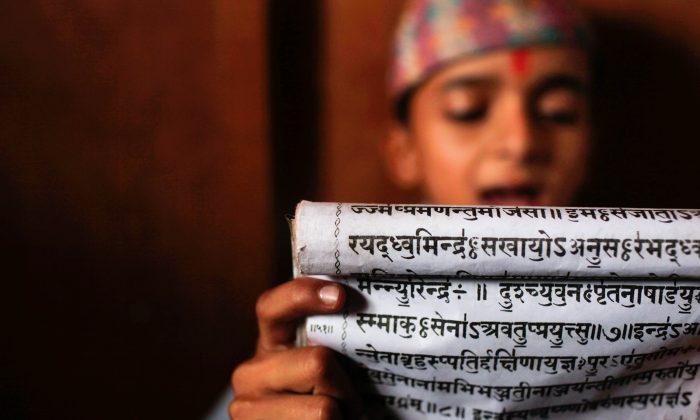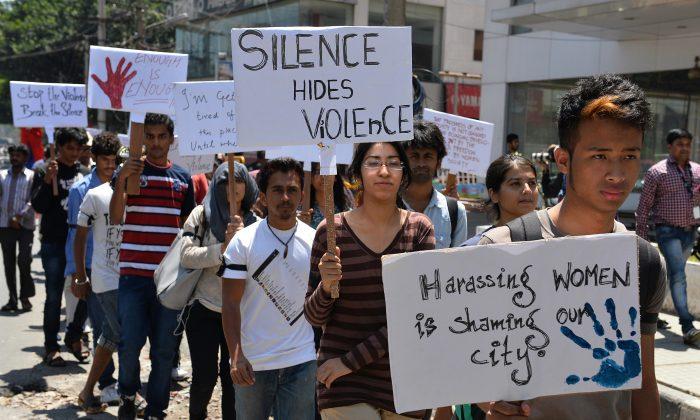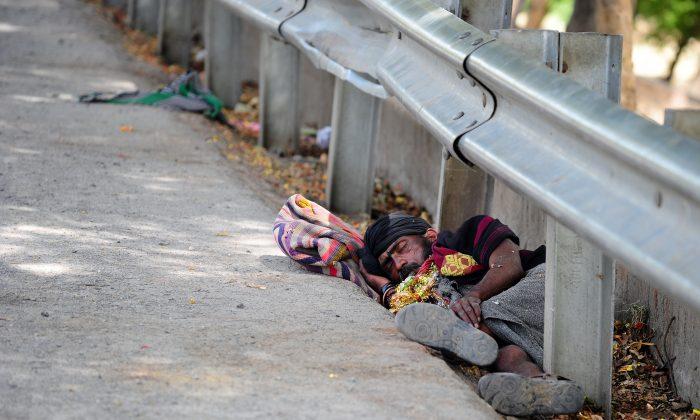The new Indian government has engaged the country in a controversial revival of a relatively obscure ancient language. So far, it has required students to replace the study of German with Sanskrit in about 500 public schools.
In 2014, the Indian Ministry of Human Resource Development declared that the teaching of German in Kendriya Vidyalaya schools was contradictory to the country’s “three language policy,” which requires students to study English, Hindi, and one regional or classical language. The ministry said that foreign languages could only be taught as optional languages in state-run schools.
Efforts to popularize Sanskrit have won praise and support from language scholars. However, the government is coming under fire from those who believe the state-sponsored lessons are part of a larger attempt to impose Hindu culture on the nation.
Sanskrit is part of the Indo-Aryan group of languages—the root of many languages spoken in India today. However, Sanskrit has always been a largely liturgical language, found in sacred texts and used by Hindu priests while conducting ceremonies. According to a 2001 census, only 14,000 Indians or 0.001 percent of the population reported Sankrit as their first language.
When India gained independence from the British in 1947, Sanskrit was included in the list of official languages in the Constitution. Since then, the government has made efforts to revive interest in the language. Sanskrit can be studied as an optional language in most public and private schools all over the country. Many local arms of the state-owned radio broadcaster All India Radio broadcast Sanskrit learning programs.

Sanskrit is still largely limited to academic circles today. However, when Prime Minister Narendra Modi’s Bharatiya Janata Party came to power last year, Sanskrit supporters became optimistic. Since the language has deep roots in Hinduism, the hope was that this shift in power towards the Indian political right (historically associated with the ideology of Hindutva or Hindu nationalism) would spell good times for Sanskrit.
Champions of the cause celebrated when the government scrapped German for Sanskrit in public schools late last year. Many praised this shift from a foreign to a local language, while some parents of the nearly 70,000 children affected criticized the move. German Chancellor Angela Merkel reportedly raised the issue with Modi during the G20 summit in Brisbane, Australia, last November, but the details were not made public.
State-run television broadcaster Doordarshan announced this month that it would air a weekly news segment in Sanskrit.
For the most part however, contemporary spoken Sanskrit has remained largely isolated to just a few pockets across the country.
One such pocket is the village of Mattur in the southern state of Karnataka. About one-third of this hamlet of 1,500 individuals know some amount of Sanskrit, and the language is used to communicate on a daily basis.
Sanskrit is also the lingua franca of the tiny village of Jhiri, in the central Indian state of Madhya Pradesh. Places like Mattur and Jhiri are cited by casual supporters of the revival as evidence that Sanskrit isn’t dead, and has relevance in the modern world.
Political Agenda
Historically, Sanskrit was limited to the priestly Brahmin caste, the uppermost caste in Indian society. One of the major appeals of the relatively newer religions of Jainism and Buddhism, was the fact that their teachings were spread in the vernacular language.
These religions became immensely popular in India until the reformation of Brahmanism, when Brahmin rulers adopted Buddhist ideology and imagery, and began preaching in vernacular languages, to create what would eventually be called Hinduism.
As such, Sanskrit has never been the language of the majority of India’s population, especially in east and south India, where local languages developed independent of Sanskrit. States in these parts of the country even spearheaded the resistance to replace English with the Sanskrit-derived Hindi as the official language of government in the latter half of the 20th century.
In Mattur, the ‘Sanskrit Village’ as it’s called by Sanskrit revivalists, the language is limited to the Brahmin families who migrated there some 600 years ago. The common man still speaks the local Kannada.
One of the organizations spearheading the Sanskrit revival, is the Bangalore-based Samskrita Bharati. They teach a simplified communicative version of the classical language, and have campuses all over India, and even one in San Jose, Calif.
Samskrita Bharati is part of the Sangh Parivar (Family of Sangh), a group of Hindu nationalist organizations. It includes the Rashtriya Swayamsevak Sangh (National Volunteer Organization) or RSS, a Hindu nationalist organization that has often been criticized as an extremist group and has been banned several times in independent India’s history, and the militant Vishwa Hindu Parishad.
The RSS is an integral part of Modi’s Bharatiya Janata Party, which draws on the former’s grassroots power for support. In the past, the BJP has rarely done anything contrary to the RSS’s wishes. Modi himself used to be a Pracharak (regional head) of the RSS.
The RSS has been accused of links to several terror plots in India, including attacks on mosques. A report by the Liberhan Commission, led by retired High Court Judge M.S. Liberhan to investigate the demolition of the 600-year-old Babri Mosque and subsequent inter-religious conflict, found that the RSS was explicitly involved. The construction of a Hindu temple in the location believed to be the site of the mythological figure Rama’s birth, is a key mission of the Modi government.
A former leader of the RSS, M.S. Golwalkar, wrote in his book “We, or Our Nation Defined:” “The non-Hindu people of Hindustan [India] must either adopt Hindu culture and languages, must learn and respect and hold in reverence the Hindu religion, must entertain no idea but of those of glorification of the Hindu race and culture … or may stay in the country, wholly subordinated to the Hindu nation, claiming nothing, deserving no privileges, far less any preferential treatment—not even citizens’ rights.”
Though the RSS and Modi’s party have since distanced themselves from Golwalkar’s extreme views, the ideology of Hindutva is key to the Indian right wing. It’s impossible to see Sanskrit revival as independent of this ideology under the current government, as long as it remains a source of Hindu pride.
Political threads run through many of Samskrita Bharati’s lessons, even as they claim to have secularized the language.
Last year, Patrick McCartney, a Ph.D. student at the Australian National University), wrote a paper on the time he spent with Samskrita Bharati. His paper included instances where Sanskrit grammar was taught using political jokes, lampooning the opposition Party in government, and idolizing prominent Hindus from India’s past.




Friends Read Free